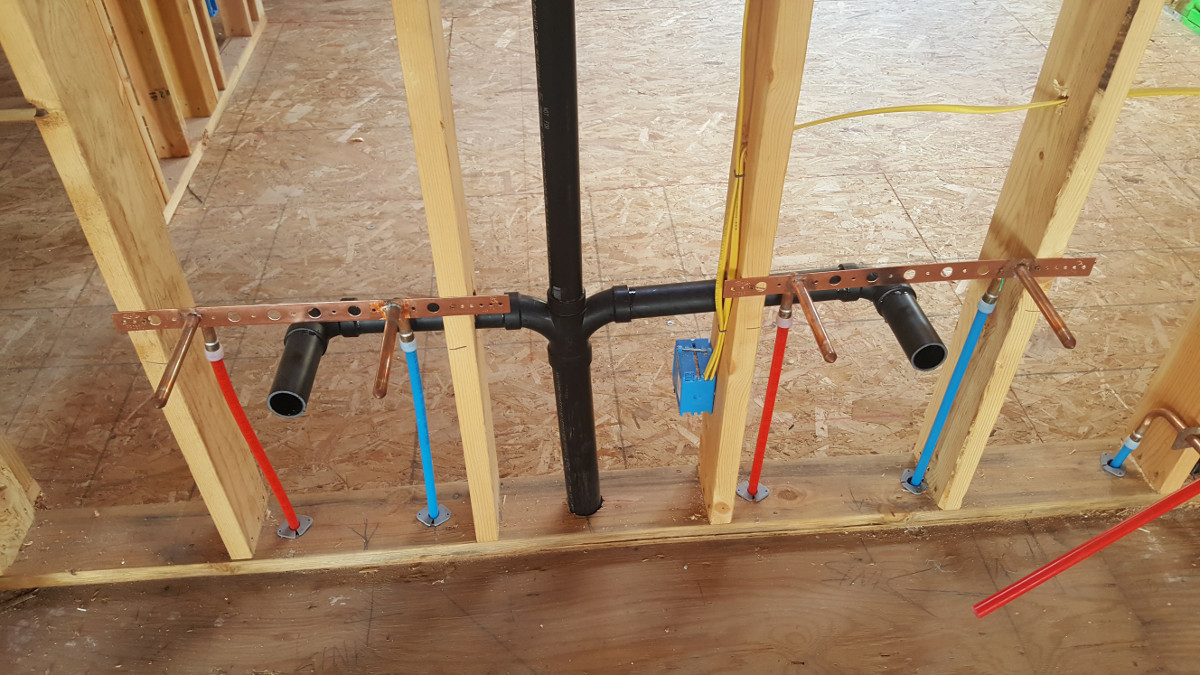Sink Installation Preparation

Before you begin installing your bathroom sink, it’s important to prepare the plumbing rough-in. This involves measuring and marking the location of the sink, as well as installing the necessary plumbing fixtures.
Tools and Materials
You will need the following tools and materials for bathroom sink plumbing rough-in:
- Measuring tape
- Level
- Pencil
- Stud finder
- Drill
- Screwdriver
- Pliers
- Pipe wrench
- Sink drain
- Faucet
- Supply lines
- P-trap
Measuring and Marking the Location of the Sink
Once you have gathered your tools and materials, you can begin measuring and marking the location of the sink.
- Measure the distance from the center of the drain hole to the back of the sink.
- Transfer this measurement to the wall, and mark the location of the center of the drain hole.
- Measure the distance from the center of the drain hole to the left and right sides of the sink.
- Transfer these measurements to the wall, and mark the location of the left and right sides of the sink.
- Use a level to ensure that the sink is level from side to side.
Plumbing Rough-In Process

Bathroom sink plumbing rough in – Installing the drainpipe and supply lines for a bathroom sink is a crucial step in the plumbing rough-in process. It involves connecting the sink to the main water supply and drainage system, ensuring proper water flow and waste disposal.
Before beginning the rough-in, it’s essential to understand the different types of drainpipes and supply lines available, as well as the importance of using proper fittings and sealing connections to prevent leaks and ensure a functional plumbing system.
Drainpipe Installation
- Determine the type of drainpipe to be used, such as PVC (polyvinyl chloride), ABS (acrylonitrile butadiene styrene), or copper.
- Cut the drainpipe to the desired length and connect it to the sink drain using a slip joint nut.
- Apply sealant around the connection to prevent leaks.
- Connect the other end of the drainpipe to the main drain line using a wye fitting or a sanitary tee.
- Secure the drainpipe using pipe clamps or hangers.
Supply Line Installation
- Identify the hot and cold water supply lines and connect them to the appropriate valves on the sink.
- Use flexible supply lines for ease of installation and to prevent kinking.
- Tighten the connections using a wrench or pliers.
- Apply sealant around the connections to prevent leaks.
- Turn on the water supply and check for any leaks.
By following these steps and using proper materials and techniques, you can ensure a successful plumbing rough-in for your bathroom sink, providing a reliable and functional water supply and drainage system.
Sink and Faucet Installation: Bathroom Sink Plumbing Rough In

Sink and faucet installation is a crucial step in completing a bathroom renovation. It involves connecting the sink to the plumbing system and installing the faucet to provide water flow. This process requires careful planning and attention to detail to ensure a leak-free and functional setup.
Sink Mounting Options
There are various sink mounting options available, each with its own advantages and disadvantages.
- Undermount Sinks: These sinks are installed beneath the countertop, creating a seamless and modern look. They offer easy cleaning and a durable bond when properly sealed with plumber’s putty or caulk.
- Drop-In Sinks: These sinks are the most common type, resting directly on the countertop. They are easy to install and provide a traditional look, but they may be more prone to water damage around the edges.
- Vessel Sinks: These sinks sit above the countertop, creating a unique and eye-catching focal point. They are often used in powder rooms or guest bathrooms and require a specific type of faucet designed for vessel sinks.
Faucet Installation, Bathroom sink plumbing rough in
Faucet installation involves connecting the faucet to the water supply lines and securing it to the sink or countertop.
- Deck-Mounted Faucets: These faucets are mounted directly onto the sink or countertop, with the handles and spout rising above the surface.
- Wall-Mounted Faucets: These faucets are mounted on the wall behind the sink, with the spout extending over the sink. They provide a clean and modern look, but require more complex plumbing work.
Sealing the Sink
To prevent leaks, it is essential to properly seal the sink to the countertop. This can be done using plumber’s putty or caulk.
- Plumber’s Putty: A pliable material that is applied around the sink flange and pressed into place to create a watertight seal.
- Caulk: A silicone-based sealant that is applied around the sink flange and smoothed out to create a flexible and waterproof barrier.
Planning a bathroom renovation? Don’t forget about the essential plumbing rough-in for your bathroom sink. Once that’s taken care of, you can start envisioning your dream bathroom. If you’re going for a sophisticated and modern look, consider a black bathroom vanity with sink.
The sleek black finish will add a touch of elegance to your space, and the ample storage will keep your bathroom essentials organized. When it comes to the plumbing rough-in, be sure to follow the manufacturer’s instructions carefully to ensure a proper installation.
While planning the bathroom sink plumbing rough in, it’s crucial to consider the bathroom sink drain parts. These components, including the drainpipe, P-trap, and strainer, ensure proper drainage and prevent clogs. The rough in involves determining the drainpipe’s location and slope to facilitate efficient water flow.
Understanding the various bathroom sink drain parts helps ensure a functional and well-designed plumbing system.